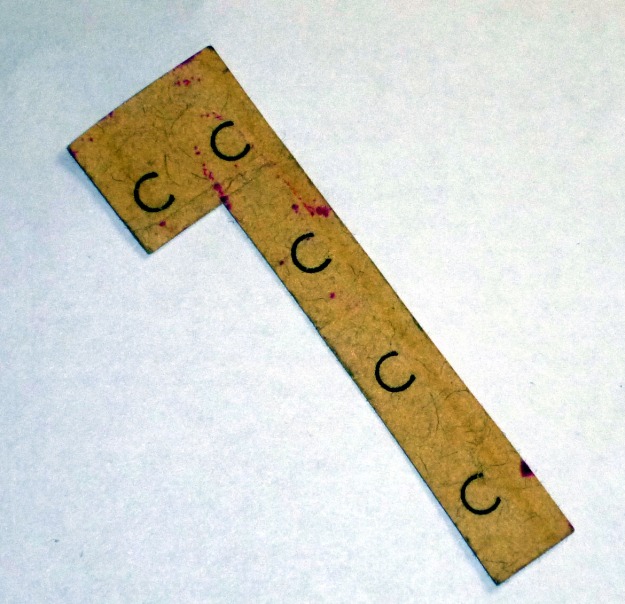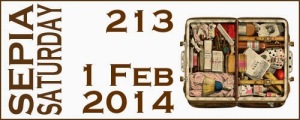Suitcases are our theme for this week. It was impossible to go on holiday without a suitcase. Sometimes it even came in handy as a seat,
 Barbara and Charles Fricke c1940 holidaying at Hastings, a small town on Westernport Bay in Victoria, They were staying with Charles’s sister on an orchard, a couple of miles out of town. I suspect that Barbara was being left here on her own for a holiday. as I don’t think she would be going travelling with those muddy shoes !
Barbara and Charles Fricke c1940 holidaying at Hastings, a small town on Westernport Bay in Victoria, They were staying with Charles’s sister on an orchard, a couple of miles out of town. I suspect that Barbara was being left here on her own for a holiday. as I don’t think she would be going travelling with those muddy shoes !
Barbara and Charles Fricke again in 1943, this time walking down a street in the centre of Melbourne with a smaller suitcase while Charles sucks on his cigarette though a cigarette holder
Barbara is wearing a mixture of clothes. Remember it is wartime and clothes coupons were issued for the purchase of clothes. So… there is a navy blue hat – at least one hat was needed for wearing to church. Under the coat is a navy blue school uniform topped with a hand-knitted russet coloured cardigan with a knitted tie at the neckline to turn it into a going-out outfit.
I had always thought of the rationing in Australia as being due to shortages but apparently the reasons were more complex. It’s also a bit embarrassing to even think about it when you think of the severe rationing in Britain.
The Australian War Memorial Web site tells us …..
“Rationing regulations for food and clothing were gazetted on 14 May 1942. Rationing was introduced to manage shortages and control civilian consumption. It aimed to curb inflation, reduce total consumer spending, and limit impending shortages of essential goods. The broad reasoning behind the introduction of rationing was to ensure the equitable distribution of food and clothing. It was also hoped that a cut on consumer spending would lead to an increase in savings, which in turn could be invested in war loans.
Australians were never as short of food nor rationed as heavily as civilians in the United Kingdom. Rationing was enforced by the use of coupons and was limited to clothing, tea, sugar, butter, and meat. From time to time, eggs and milk were also rationed under a system of priority for vulnerable groups during periods of shortage.”
Go to Sepia Saturday for more links to people’s adventures with their suitcases.
ctoria, south-east of the capital Melbourne.




I have some Australian ration coupons from WW2 amongst the memorabilia here, somewhere, I must dig them out and have another look at them. I think they were for butter.
The second photo was taken by a street photographer I presume, I wonder whether he just handed you a business card and you followed it up with the order, or whether you ordered on the spot.
LikeLike
The first photograph looks so much more relaxed and pleasant than the business like one on the sidewalk. I guess school and work do that to you.
LikeLike
I don’t think we had clothing rationing here. I heard that maybe dresses were so short in the 1940s because they used less material, and I think nylon stockings were not available.
LikeLike
I do recall reading and hearing about some things that were in ration. Interesting post.
LikeLike
I remember seeing some WW II food rationing tickets for meat and, I think, butter and sugar which my Mom kept in her cedar chest’s top tray for a long time. Don’t know if she still has them? I’ll have to ask her. I don’t think they ever had to ration clothing, however.
LikeLike
Oh wait a minute – I have her cedar chest now & nope, no ration tickets. Maybe she still keeps them elsewhere?
LikeLike
I didn’t realize there was rationing in Australia as well. I used to live near the Hastings in England, which is now a bit on the rough side!
LikeLike
Oh no, you could never go visiting with dirty shoes!
My mum spoke about rationing and how her grandparents used to send farm produce to them in the city.
LikeLike
Super photos to choose. SInce clothing was usually made of wool or cotton in those years, it had to be rationed in part because both materials were necessary for military products. There were also problems allocating shipping and rail systems for the transport of non-military materials in wartime.
LikeLike
A lovely photograph of you with your father and I did like the pigtails. I wore my hair like that too.
LikeLike
I was aware of rationing during and after the war but can’t say what effect it had on us. I know our dogs enabled us to supplement the meat ration – no we didn’t eat them; just what they caught. I do still have some petrol coupons but they date from the fuel shortages of the 1970s.
LikeLike
Two great pictures that match the theme perfectly! My mum’s great uncle in Australia sent us food parcels of dried fruit etc so that Mum could make a Christmas cake and this continued long after the war. I remember the excitement when the parcel arrived.
LikeLike
One’s first thought is that such old suitcases must have been a dreadful nuisance – bulky, heavy and something you had to carry rather than pull on wheels or fasten over your shoulder with a strap. But as you rightly point out you could sit on it – try doing that with a soft briefcase.
LikeLike